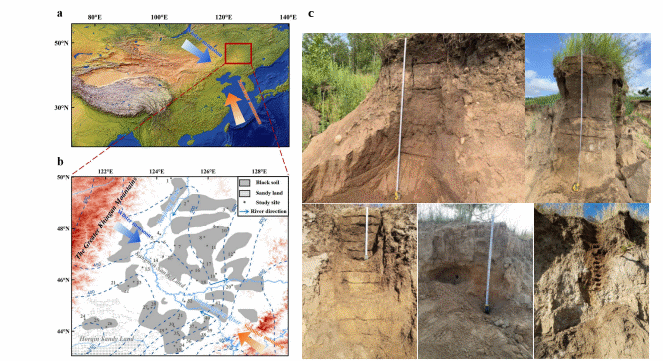From: Science Daily
Researchers from the Institute of Geology and Geophysics, Chinese Academy of Sciences (IGGCAS) have conducted extensive field investigations and sample collections in the black soil region of Northeast China. Their findings suggest that this soil was primarily transported by wind. The results have been published in the international academic journal, Catena.
YANG Shiling, the corresponding author and researcher at IGGCAS, explained, “Black soil is recognized globally as one of the most fertile soils, often referred to as the "giant panda of cultivated land.” The Northeast black soil region is a crucial grain production base in China. However, it is currently under significant threat from erosion, exacerbated by human activities. “Understanding the origin and sedimentary background of this black soil is essential for its protection.”
The team performed particle size analysis and optically stimulated luminescence (OSL) dating on the black soil and underlying sediments to explore their genesis and sedimentary background. The results indicate that the grain size distribution of the black soil in the western part of Northeast China resembles the sand loess found in the northern Loess Plateau, displaying typical aeolian characteristics. Conversely, the black soil in the eastern part exhibits similarities with the secondary loess of the alluvial plain, characterized by late hydraulic reconstruction. The findings also show that the mean particle size and sand content of the black soil decrease from coarse to fine from west to east, aligning with the prevailing wind direction during the dust storm season of the region.
ZHANG Shihao, the first author of the paper and a doctoral student at IGGCAS, stated, “Although local hydraulic transformations are present in the eastern black soil, they have not significantly altered the large scale spatial distribution pattern of particle size, which we have determined was originally transported by wind.” He added, “The chronology of our samples indicates that the black soil in Northeast China mainly formed during the Holocene, around 10,000 years ago, while the underlying deposits date back to the last glacial period, with a wide age range of 12,000 to 65,000 years ago. These findings suggest that the geomorphic conditions in the region were unstable and varied in erosion during the last glacial period, likely due to enhanced wind and water erosion from the meltwater of the surrounding mountain glaciers. In the Holocene, a warmer, wetter climate and developed vegetation allowed the aeolian materials to be preserved and evolve into organically rich black soil.”
YANG emphasized the significance of the study for the protection of the black soil in Northeast China, noting the crucial role of vegetation in the accumulation of wind-blown materials and soil development. He advocated for appropriate vegetation restoration to promote the sustainable development of black soil resources.

(a) Location of black soil in Northeast China, (b) photos of the fieldwork site, (c) cross-sections of black soil. (Image by YANG's Group)